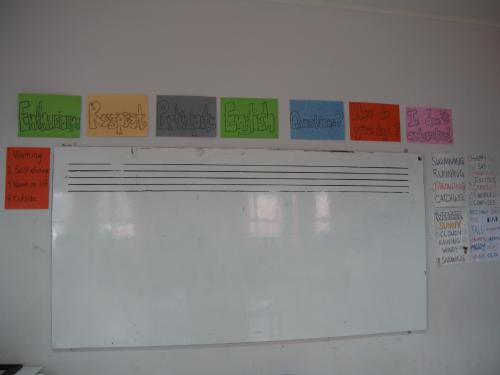
Image Credit:
Photo by Meredith Coffey, 2009
I love borrowing and tweaking a good lesson plan to meet my own students’ needs. From my first formal teacher training, when I received an enormous binder of lesson plans ready to adapt, to the DWRL’s encouragement to check out its amazing database of lab member-generated plans, I’ve been lucky enough to have regular access to other teachers’ excellent ideas. After years of reworking others’ plans, however, I’ve only recently come to terms with the fact that there is just no set formula or foolproof way to make these adaptations work flawlessly—just like any lesson plan I invent on my own.
Let me give you just two of many possible examples. Last year, I attempted to use Cate Blouke’s plan for using Prezi to introduce the course syllabus. Following her instructions diligently, I reserved plenty of time to prepare a Prezi that reflected my own course’s guidelines. When the big day came, everyone’s introductions ran long, and with limited time to spare—horror of horrors, the Prezi would not play. I tried the link I’d emailed to myself; I tried opening it through my Prezi account; I tried different browsers. Failure.
Of course, this type of technology hiccup can happen under any circumstances, borrowed lesson plan or not, but somehow it had always seemed to me that if someone had done it before successfully, then it should work smoothly in my class, too. A seriously flawed assumption, I know. So, with no Prezi to show for all that preparation, I had to make that move with which every teacher is all too familiar—I had to come up with an entirely different plan on the spot. I promptly directed the students to review the syllabus in small groups and then present key information to the rest of the class. It wasn’t a terribly exciting icebreaker, but at least they had to learn some of each others’ names, read the syllabus closely, and speak just briefly in front of the class. My takeaway from that experience, then, was that even when you think you’re relying on a tried-and-true plan, you still have to remain able to adapt, and keep adapting, as circumstances require.
My second example comes from just a few weeks ago, when I was teaching Sherman Alexie’s The Lone Ranger and Tonto Fistfight in Heaven and decided to borrow from Andy Uzendoski’s Lit Genius close reading activity. I followed his guidelines closely: before class, I added five passages from assigned short stories to Lit Genius; I broke them into five small groups, one to annotate each passage; and I had them present their annotations to the class. Overall, this exercise went extremely well. Several of the students were already familiar with Genius (particularly Rap Genius), and something about the digital format made creating annotations seem exciting and novel. Some groups went beyond the exercise’s requirements, adding images to their annotations, for instance. Indeed, it was popular enough that for a later presentation assignment, one group elected to use Lit Genius to share their work.
Once again, though, an unanticipated challenge arose. By and large, the groups spent much longer discussing and annotating their assigned passages than I’d anticipated. The posted lesson plan had warned that the activity could take one to two class periods, but I imagined that if we began right at the start of class, we could manage the complete exercise (one round of annotations, a round of mini-presentations, and another round of annotations of another group’s passage) in one seventy-five minute class period. As will probably not be surprising to readers of this post, this estimation turned out to be overly optimistic. I wound up extending the activity to the next class session, which was not ideal but was certainly doable.
This time around, I couldn’t pin the plan’s failure on a technology problem. Instead, it was an issue of my not having revised the plan sufficiently to meet my timeframe requirements. Even though I knew that the plan could potentially take up to two class sessions, I didn’t sufficiently limit the length of the excerpts, the close reading questions to ask, etc., to make it work for my particular group of students. Sticking closely to script made the exercise an overall success, but further work on my end to hone the plan would have made the execution go even more smoothly.
Of course, the amount of revision necessary to adapt to a lesson plan varies significantly. Sometimes plans turn out to be too short instead of too long (rarely my problem, but it happens!). Indeed, all sorts of challenges can arise while constructing or implementing a lesson plan. All this is to say that I remain a huge fan of adapting others’ lesson plans to work for my own classes—and sometimes sharing my own plans with others—but one of the many skills I continue to develop is that of the adaptation/revision process itself. Process over product, after all.

